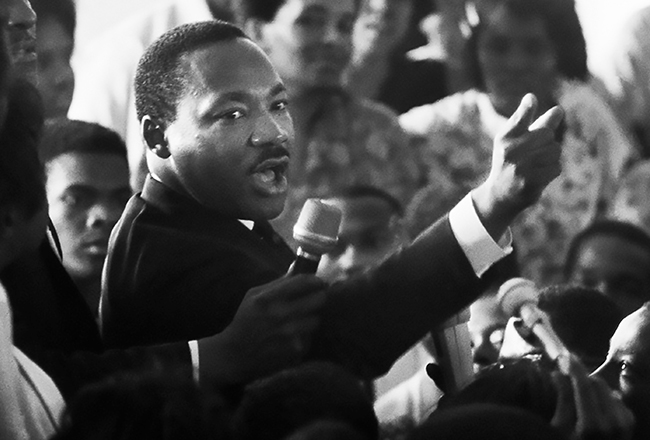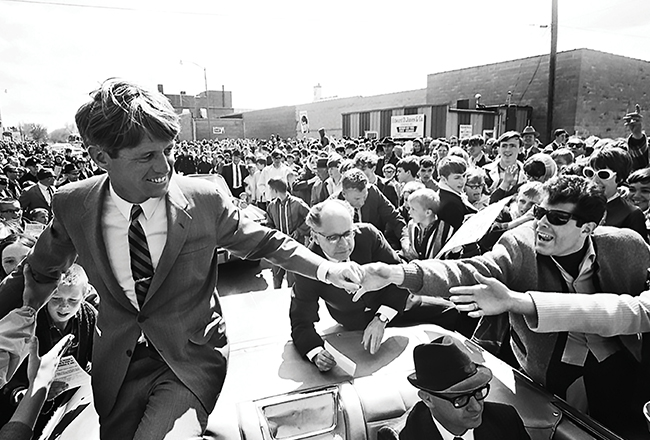“The Promise and the Dream” — a new book by Connecticut-raised David Margolick — tells the story of two great men on parallel roads that intersected in tragedy.
Like “Rebel Spirits,” the small but incandescent recent New-York Historical Society exhibit that was its byproduct, the compelling book considers the lives and increasingly dovetailing work of Robert F. Kennedy and Martin Luther King Jr. — two men bound by history, by civil rights activism and, in the end, by death. June 6 marks the 50th anniversary of Kennedy’s assassination in Los Angeles when he was 42 — two months and two days after King was assassinated in Memphis at age 39.
Yet, the two men were in each other’s presence only a dozen or so times. Indeed, the book as well as the exhibit — created and curated by journalist, movie producer and author Lawrence Schiller, who also commissioned the book — have shared the only photograph in which King and Kennedy appeared side by side. On June 22, 1963, they posed with Vice President Lyndon B. Johnson and other leaders in the Rose Garden of the White House — Kennedy, then attorney general, smiling, seemingly untroubled; King gazing away from the camera, distracted, no doubt because President John F. Kennedy had just confided to King that he was under “very close” FBI surveillance, in part for having alleged communist associates. That photograph tells you everything about the worlds that separated King and Robert Kennedy, so much so that when Margolick met with Kathleen Kennedy Townsend, the first of Robert Kennedy’s 11 children, he says she told him that he didn’t have a book.
But the Putnam, Connecticut-raised Margolick — a longtime contributing editor to Vanity Fair and the former legal affairs reporter for The New York Times — said, “I took that as a challenge.”
What he concluded in taking up that challenge — he said as he walked us through the exhibit — was that King and Kennedy “were in the same universe, aware of one another and cared about the same thing. But they came at it from different angles and at a different pace.
“(Former Kennedy aide) William vanden Heuvel said, ‘They approached the top of the mountain at the same time but from different sides.’…Bobby was much slower to come to a civil rights agenda. But they ended in the same place.”
Growing up in Bronxville and Hyannis Port, Massachusetts, the devout seventh of nine children in the formidable Kennedy family, “Bobby Kennedy emerged knowing very little about black people,” says Schiller, who met him in 1961 through Kennedy brother-in-law Peter Lawford and at Marilyn Monroe’s house and later became one of his personal photographers.
Nor did Kennedy’s early association with Sen. Joseph McCarthy’s anti-communist witch hunt in the 1950s do much to inspire the minorities and liberals who would later come to see him as a champion. Soon, Kennedy would be immersed in making his adored, glamorous older brother president of the United States, which meant walking a fine line between civil rights justice and courting the South, where civil rights were anathema.
“There’s a wonderful story in the book of Bobby driving in an open convertible in Harlem and a kid runs up beside him and says, ‘Give me five,’” Schiller says. “The driver had to explain this was a term of endearment.” Kennedy thought the boy wanted money.
Just as Kennedy had to open himself up to the poverty, prejudice and horrific violence blacks endured, King had to educate himself about white people, Schiller adds. The bigotry he had witnessed and experienced growing up in Atlanta as the middle child of a father as tough at Joseph P. Kennedy — the Rev. Martin Luther King Sr. — had taught him to be wary of whites and powerful men like the Kennedys in particular.
“As the great (pitcher) Satchel Paige once observed, ‘White man still in the lead,’” Margolick says.
What broke the ice and cemented a relationship of sorts was the Kennedy outreach to King and his then-pregnant wife, Coretta, when King was thrown in a rural Georgia penitentiary for driving with expired plates and an Alabama license several months before the presidential election of 1960. John Kennedy called King’s distraught wife while Robert Kennedy worked to free King. JFK’s presidential opponent, Richard Nixon, did nothing. It may have cost Nixon the election.
And yet, post-election, King and the Kennedys would dance a careful two-step as they negotiated civil rights legislation during one of the bloodiest, most dangerous periods of the civil rights movement. King was still navigating between mainstream blacks and militants, both of whom were dissatisfied with him for different reasons, while the Kennedys were striving to redress inequality while retaining the image of a unified America at home and abroad. It wasn’t until a year after the assassination of President Kennedy on Nov. 22, 1963, that the Civil Rights Act would be passed. That same year, Robert Kennedy would be elected to the U.S. Senate from New York and continue the journey of enlightenment as an anti-poverty, pro-worker and civil rights activist.
Ultimately, King, the polished preacher, and Robert Kennedy, the visceral politician, were very different men with different roles to play on the world stage. And so it is not surprising to learn from Margolick and Schiller that they had different attitudes toward the destination that awaits us all.
“There’s no question that Martin Luther King feared death since he was stabbed,” Schiller said, referring to a 1958 incident in Harlem in which a mentally ill woman plunged a letter opener into his chest at a book signing. “After that, he was always looking over his shoulder. Bobby didn’t care if he died. He was a fatalist.”
Many look at King’s “I’ve been to the mountaintop” speech — delivered in Memphis the day before he was assassinated — as a Lincolnesque premonition of and meditation on death, although Margolick said King used similar language in a 1957 speech in Montgomery, Alabama. It’s worth quoting part of the 1968 speech here as it is one of the great speeches in American history:
“Well, I don’ know what will happen now. We’ve got some difficult days ahead. But it really doesn’t matter with me now, because I’ve been to the mountaintop. And I don’t mind. Like anybody, I would like to live a long life — longevity has its place. But I’m not concerned about that now. I just want to do God’s will. And he’s allowed me to go up to the mountain. And I’ve looked over and I’ve seen the Promised Land. I may not get there with you. But I want you to know tonight that we, as a people, will get to the Promised Land. And so I’m happy tonight. I’m not worried about anything. I’m not fearing any man. Mine eyes have seen the glory of the coming of the Lord.”
The speech was followed the next night by another of America’s great speeches, Margolick said, this one delivered in a black neighborhood in Indianapolis by presidential candidate Kennedy, who broke the news of King’s death:
“For those of you who are black and are tempted to be filled with hatred and mistrust of the injustice of such an act, against all white people, I would only say that I can also feel in my own heart the same kind of feeling. I had a member of my own family killed, but he was killed by a white man.”
Kennedy went on, “My favorite poet was Aeschylus and he once wrote, ‘Even in our sleep, pain which cannot forget falls drop by drop upon the heart until, in our own despair, against our will, comes wisdom through the awful grace of God.”
Other American cities burned that night but not Indianapolis. Two months and two days later, Kennedy was dead.
“I’m going to say something risky,” Schiller said, prefacing his remarks on the pair’s legacies. “Sometimes people taken from us achieve more in death than in life.”
Consider, Margolick said, the hit Dion song “Abraham, Martin and John,” which linked Lincoln, King and the Kennedy brothers as martyrs to freedom.
“These are moments in time, snapshots of an era,” Margolick added of the images in the exhibit and the book that captured King and Robert Kennedy’s journeys — now forever entwined in the imagination. “But in a sense, they are misleading. They suggest artists of another era. They seem more resonant than they should be.”
David Margolick’s “The Promise and the Dream: The Untold Story of Martin Luther King Jr. and Robert F. Kennedy” (Rosetta Books, $30, 400 pages) is now available. For more on the recent exhibit “Rebel Spirits: Robert F. Kennedy and Martin Luther King Jr.,” visit nyhistory.org.






